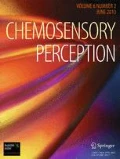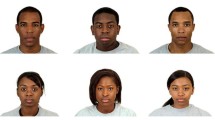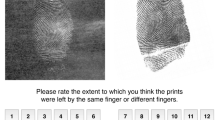Abstract
Sensory thresholds are defined according to a criterion level of performance in a particular psychophysical task. Thus, thresholds are a function of both subject sensitivity and method. However, relatively few studies have directly compared methods using the same subjects and stimulus. In the current work, thresholds for amyl acetate were measured for 19 subjects using three different methods. Results from a modified method of constant stimuli, which directly measures full detection functions, served as a “gold standard” to establish validity. These results were compared to two less intensive “shortcut” methods, viz., a forced-choice ascending method of limits and a staircase procedure. Both rapid methods produced mean threshold values comparable to those from the method of constant stimuli. Thus, both methods provided a reasonable estimate of average threshold. For characterizing individual differences, the validity of both methods seemed largely limited by their reliability. The staircase procedure may outperform the ascending method of limits in characterizing individual differences, but neither method is exceptionally strong in this respect.





Similar content being viewed by others
References
Allen MJ, Yen WM (2002) Introduction to measurement theory. Waveland Press, Long Grove, IL, USA
Amoore JE, Hautala E (1983) Odor as an aid to chemical safety: odor thresholds compared with threshold limit values and volatilities for 214 industrial chemicals in air and water dilution. J Appl Toxicol 3(6):272–290
ASTM International (2004) E679-04: Standard practice for determination of odor and taste threshold by a forced-choice ascending concentration series method of limits. ASTM International, Philadelphia, PA, USA
Bohrnstedt GW (1983) Measurement. In: Rossi PH, Wright JD, Anderson AB (eds) Handbook of survey research. Academic, San Diego, CA, USA, pp 69–121
Brown KS, Maclean CM, Robinette RR (1968) The distribution of the sensitivity to chemical odors in man. Hum Biol 40(4):456–472
Cain WS, Gent JF (1991) Olfactory sensitivity: reliability, generality, and association with aging. J Exp Psychol Hum Percept Perform 17(2):382–391
Cain WS, Schmidt R, Wolkoff P (2007) Olfactory detection of ozone and d-limonene: reactants in indoor spaces. Indoor Air 17(5):337–347
Cometto-Muñiz JE, Cain WS, Hiraishi T, Abraham MH, Gola JM (2000) Comparison of two stimulus-delivery systems for measurement of nasal pungency thresholds. Chem Senses 25(3):285–291
Cometto-Muñiz JE, Cain WS (1995) Olfactory adaptation. In: Doty (ed) Handbook of olfaction and gustation. Marcel Dekker, New York, USA, pp 257–281
Cometto-Muñiz JE, Cain WS, Abraham MH (2003) Quantification of chemical vapors in chemosensory research. Chem Senses 28(6):467–477
Cometto-Muñiz JE, Cain WS, Abraham MH (2005) Odor detection of single chemicals and binary mixtures. Behav Brain Res 156(1):115–123
Devos M, Patte F, Rouault J, Laffort P, Van Gemert LJ (1990) Standardized human olfactory thresholds. IRL Press, Oxford
Doty RL, McKeown DA, Lee WW, Shaman P (1995) A study of the test–retest reliability of 10 olfactory tests. Chem Senses 20(6):645–656
García-Pérez MA (1998) Forced-choice staircases with fixed step sizes: asymptotic and small-sample properties. Vis Res 38(12):1861–1881
Gaffney SH, Paustenbach DJ (2007) A proposed approach for setting occupational exposure limits for sensory irritants based on chemosensory models. Ann Occup Hyg 51(4):345–356
Harvey LO Jr (1986) Efficient estimation of sensory thresholds. Behav Res Meth Instrum Comput 18(6):623–632
Hawkes C (2006) Olfaction in neurodegenerative disorder. Adv Otorhinolaryngol 63(1):133–151
Lawless HT, Heyman H (1998) Sensory evaluation of food: principles and practices. Chapman & Hall, New York, USA
Levitt H (1970) Transformed up-down methods in psychoacoustics. J Acoust Soc Am 49(2):476–477
Linschoten MR, Harvey LO, Eller PM, Jafek BW (2001) Fast and accurate measurement of taste and smell thresholds using a maximum-likelihood adaptive staircase procedure. Percept Psychophys 63(8):1330–1347
Lötsch J, Lange C, Hummel T (2004) A simple and reliable method for clinical assessment of odor thresholds. Chem Senses 29(4):311–317
Lötsch J, Reichmann H, Hummel T (2008) Different odor tests contribute differently to the evaluation of olfactory loss. Chem Senses 33:17–21
Macmillan NA, Creelman CD (1991) Detection theory: a user’s guide. Cambridge University Press, New York, USA
Menashe I, Abaffy T, Hasin Y, Goshen S, Yahalom V, Luetje CW, Lancet D (2007) Genetic elucidation of human hyperosmia to isovaleric acid. PLoS Biol 5(11):e284 DOI 10.1371/journal.pbio.0050284
Punter PH (1983) Measurements of human olfactory thresholds for several groups of structurally related compounds. Chem Senses 7(3):215–235
Smeets MA, Bulsing PJ, van Rooden S, Steinmann R, de Ru JA, Ogink NW, van Thriel C, Dalton PH (2007) Odor and irritation thresholds for ammonia: a comparison between static and dynamic olfactometry. Chem Senses 32(1):11–20
Stevens JC, Cain WS (1987a) Detecting gas odor in old age. Ann NY Acad Sci 510(1):644–646
Stevens JC, Cain WS (1987b) Old-age deficits in the sense of smell as gauged by thresholds, magnitude matching, and odor identification. Psychol Aging 2(1):36–42
Stevens JC, Cain WS, Burke RJ (1988) Variability of olfactory thresholds. Chem Senses 13(4):643–653
Van Gemert LJ (1999) Compilations of odour threshold values in air and water. TNO Nutrition and Food Research Institute, Boelens Aroma Chemical Information Service (BACIS), Huizen, The Netherlands
Walker JC, Hall SB, Walker DB, Kendal-Reed MS, Hood AF, Niu XF (2003) Human odor detectability: new methodology used to determine threshold and variation. Chem Senses 28(9):817–826
Wetherill G, Levitt H (1965) Sequential estimation of points on a psychometric function. Br J Math Stat Psychol 18(1):1–10
Wise PM, Miyazawa T, Gallagher M, Preti G (2007) Human odor detection of homologous carboxylic acids and their binary mixtures. Chem Senses 32(5):475–482
Wysocki CJ, Beauchamp GK (1984) Ability to smell androstenone is genetically determined. Proc Natl Acad Sci U S A 81(15):4899–4902
Wysocki CJ, Cowart BJ, Radil T (2003) Nasal trigeminal chemosensitivity across the adult life span. Percept Psychophys 65(1):115–122
Wysocki CJ, Wise P (2003) Methods, approaches, and caveats for functionally evaluating olfaction and chemesthesis. In: Deibler KD, Delwiche J (eds) Handbook of flavor characterization: sensory analysis, chemistry and physiology. Marcel Dekker, New York, USA, pp 1–40
Yoshida M (1984) Correlation analysis of detection threshold data for ‘standard test’ odors. Bulletin of the Faculty of Science and Engineering Chuo University 27(2):343–353
Author information
Authors and Affiliations
Corresponding author
Rights and permissions
About this article
Cite this article
Wise, P.M., Bien, N. & Wysocki, C.J. Two Rapid Odor Threshold Methods Compared to a Modified Method of Constant Stimuli. Chem. Percept. 1, 16–23 (2008). https://doi.org/10.1007/s12078-008-9010-8
Received:
Accepted:
Published:
Issue Date:
DOI: https://doi.org/10.1007/s12078-008-9010-8




